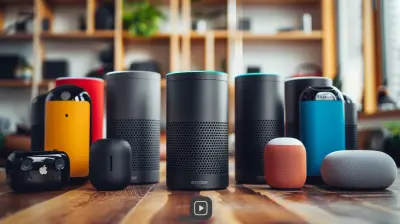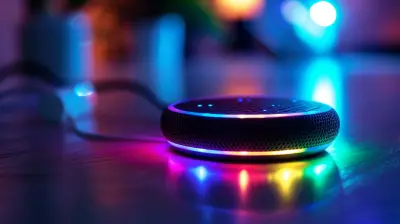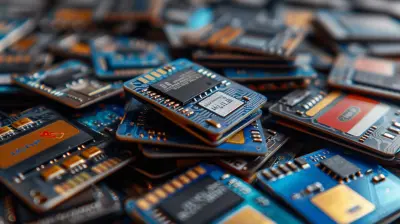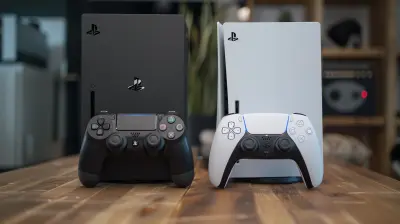How Smartwatches Are Evolving Beyond Fitness Tracking
21 January 2025
Smartwatches have become a part of our everyday lives. Initially, they were seen as fancy extensions of our smartphones, and then came the fitness craze—tracking steps, counting calories, heart rate monitoring, and all that jazz. But here's the thing: smartwatches are no longer just fitness trackers strapped to your wrist. They’re evolving—fast. In fact, they’re shaping up to be an integral part of our digital lives, offering way more than just counting how many steps you’ve taken today.
So, what exactly does that mean? Well, let’s dive into how smartwatches are becoming more than just fitness buddies and are stepping into new domains.
![]()
The Early Days: Fitness Tracking Was King
Before we discuss all the new and shiny features, let’s take a stroll down memory lane. Do you remember when the primary function of a smartwatch was fitness tracking? Back in the day, wearing a smartwatch was all about knowing how many steps you took, how many calories you burned, and whether you hit your daily 10,000-step goal. Fitness tracking was the bread and butter of early smartwatches, and to be fair, it’s still a huge selling point today.But as useful as it is to know how many steps you’ve taken, the smartwatch industry knew people wanted more. Much more.
![]()
Health Monitoring: Beyond Simple Step Counting
While fitness tracking has been a major selling point, smartwatches are now moving toward more sophisticated health monitoring systems. It's no longer just about tracking your daily jog or monitoring your heart rate. Devices like the Apple Watch, Samsung Galaxy Watch, and Fitbit have evolved to measure advanced health metrics that can genuinely improve your life.ECG and Blood Oxygen Monitoring
One of the most significant advancements in smartwatch technology? ECG (Electrocardiogram) and blood oxygen monitoring (SpO2). These features go beyond the realm of fitness and delve into actual health diagnostics. With an ECG, you can monitor your heart’s electrical activity, and some smartwatches can even detect irregularities like atrial fibrillation—a condition that could lead to strokes if untreated.Blood oxygen sensors, on the other hand, help measure how well your body is distributing oxygen. These features are especially handy in monitoring sleep apnea or helping people understand their oxygen levels when working out at high altitudes. It’s like having your own mini health clinic strapped to your wrist.
Stress and Sleep Tracking
Stress is a silent killer, and modern smartwatches are recognizing this. By monitoring heart rate variability (HRV) and other metrics, some wearables can now give you an idea of how stressed you are. But they don’t stop there—many will even guide you through breathing exercises to help you calm down and relax. It's like having your own personal Zen coach.And let’s not forget sleep tracking. Sure, fitness bands could already tell you how long you slept, but now smartwatches are taking it a step further. They monitor REM cycles, deep sleep, and even how many times you toss and turn during the night. With this kind of data, you can adjust your habits to improve the quality of your sleep, which in turn can lead to better mental health and increased productivity during the day.
![]()
Communication: Not Just for Fitness Junkies
Remember when smartwatches were just glorified fitness trackers? Well, now they’re communication hubs, too. You don’t even need to pull out your phone anymore to stay connected. Whether you’re responding to texts, answering calls, or even sending emojis, smartwatches are becoming our new go-to for staying in touch.Texting and Calling
Most modern smartwatches now come with built-in cellular capabilities. Yep, you heard that right. You can leave your phone at home and still make calls, send texts, or even stream music while you’re out on a run or running errands. It’s like having a mini-phone on your wrist, which is perfect for those moments when you can’t, or don’t want to, carry your phone.Voice Assistants
Ever had your hands full and needed to send a quick message or check the weather? Smartwatches are stepping up with integrated voice assistants. Whether it's Siri, Google Assistant, or Alexa, you can now control various aspects of your life just by talking to your wrist. This feature is a game-changer for multitaskers, busy parents, or anyone who just loves the convenience of being able to talk directly to their devices.![]()
Smartwatches as Payment Methods: Your Wallet on Your Wrist
Digital payments are becoming the norm, and smartwatches are riding the wave. With the integration of NFC (Near Field Communication) technology, your smartwatch can now double as your wallet. Whether it’s Apple Pay, Google Pay, or Samsung Pay, all you need to do is wave your wrist over a payment terminal, and voila! Transaction complete.No more fumbling around with your wallet or digging through your purse for your card. Imagine you’re out for a jog, and you stop for a quick coffee. You don’t need to carry cash or cards—just your smartwatch. Convenient, right?
Navigation: Never Get Lost Again
Raise your hand if you’ve ever been lost in a new city or while hiking! Well, smartwatches are evolving to help with that, too. With built-in GPS and maps, your smartwatch can now guide you wherever you need to go, whether you're navigating a crowded city or exploring a mountain trail.This feature isn’t just for fitness buffs who want to track their runs or bike rides; it’s for anyone who wants to explore without relying on their smartphone. No more awkwardly pulling out your phone in unfamiliar places—your smartwatch will give you turn-by-turn directions right on your wrist.
Entertainment: More Than Just a Fitness Companion
Believe it or not, smartwatches are also becoming tiny entertainment hubs. While they won't replace your TV or tablet anytime soon, they are pushing the boundaries of what you can do on a tiny screen.Music and Podcasts
Gone are the days when you had to carry your phone to listen to music during your workout. Smartwatches now come with streaming services like Spotify, Apple Music, and more. You can sync your playlists, download songs, and even stream directly from your wrist. It’s perfect for workouts, commutes, or any time you need a little background music without the hassle of carrying extra devices.Podcasts are also becoming more accessible. You can now stream or download episodes directly to your smartwatch, making it easier to catch up on your favorite shows while on the go.
Apps and Games
Though the screen is small, developers have been creating some pretty cool apps for smartwatches. From meditation guides to language learning apps and even simple games, these tiny devices are becoming more versatile in terms of functionality and entertainment. Of course, you’re not going to play Call of Duty on your smartwatch, but for quick, on-the-go experiences, it’s a neat addition.Smart Home Control: The Command Center on Your Wrist
If you’re into smart home gadgets, you’ll love this. Smartwatches are evolving into remote controls for your smart home devices. Whether you want to turn on the lights, adjust the thermostat, or even lock your doors, you can do it all from your wrist. If you’re someone who’s invested in the smart home ecosystem, this feature is a game-changer.Imagine lying in bed and realizing you left the living room lights on. Instead of getting up, you can just tap your smartwatch, and lights out. It’s the kind of convenience that makes life a little smoother.
The Future of Smartwatches: What’s Next?
So, what’s next for smartwatches? The possibilities are endless, really. AI and machine learning are already starting to play a bigger role in how smartwatches operate. These devices are learning about our habits and routines, and soon they could start predicting what we need before we even know it ourselves.For example, your smartwatch could eventually detect subtle changes in your health before you even feel symptoms, alerting you to potential issues like dehydration or early signs of illness. Or imagine a smartwatch that can automatically adjust its settings based on where you are and what you’re doing—whether you’re exercising, working, or relaxing at home.
The evolution of smartwatches is far from over, and as they continue to integrate more AI, health diagnostics, and communication tools, they’ll likely become even more indispensable in our daily lives.
Wrapping It Up
Smartwatches have come a long way from the simple fitness trackers they once were. They’re now powerful tools for health monitoring, communication, navigation, entertainment, and even smart home control. Whether you’re a fitness enthusiast, a tech geek, or just someone who loves convenience, smartwatches are evolving to meet your needs in ways we couldn’t have imagined just a few years ago.So the next time you glance at your wrist, remember: that little device is more than just a step counter—it’s a glimpse into the future of wearable technology.
all images in this post were generated using AI tools
Category:
Latest GadgetsAuthor:

Marcus Gray
Discussion
rate this article
21 comments
Taryn McCune
It's exciting to see how smartwatches are evolving to enhance our lives beyond fitness, offering deeper connectivity and support for our well-being.
March 6, 2025 at 1:50 PM

Marcus Gray
Absolutely! Smartwatches are becoming essential tools for overall well-being, seamlessly integrating health monitoring with enhanced connectivity features.
Phaedron Matthews
Smartwatches are shedding their fitness-only image, morphing into indispensable life assistants. With features like health monitoring and mobile payments, they’re redefining convenience on our wrists—who needs a smartphone?
February 16, 2025 at 11:43 AM

Marcus Gray
Absolutely! Smartwatches are indeed transforming into essential tools that enhance daily life, seamlessly integrating health, convenience, and connectivity beyond just fitness tracking.
Kevin McGarvey
What an exciting time for tech! The evolution of smartwatches is truly remarkable, going beyond fitness tracking to enhance our daily lives in so many ways. From health monitoring to seamless connectivity, it’s amazing to see how these gadgets are reshaping our future! 🎉⌚️
February 5, 2025 at 3:53 AM

Marcus Gray
Absolutely! The evolution of smartwatches is transforming how we interact with technology and manage our health, making everyday life more efficient and enjoyable. Exciting times ahead!
Rina Murphy
What an insightful read! It's fascinating to see how smartwatches are transforming from simple fitness trackers into versatile gadgets that enhance our daily lives. The integration of health monitoring and smart features truly makes them indispensable. Excited to see what comes next!
February 4, 2025 at 8:10 PM

Marcus Gray
Thank you for your kind words! I'm glad you found the evolution of smartwatches intriguing. The future holds exciting possibilities!
Mira Sanders
Exciting to see smartwatches transforming! They’re becoming essential daily companions.
February 3, 2025 at 12:37 PM

Marcus Gray
Thank you! It's great to see how smartwatches are integrating more features to enhance our daily lives.
Beth Jenkins
Fascinating insights! I'm curious how emerging features like health monitoring and seamless connectivity will redefine our relationship with technology.
February 2, 2025 at 9:41 PM

Marcus Gray
Thank you! Emerging features like health monitoring and seamless connectivity will certainly enhance our interaction with technology, making smartwatches essential tools for personal well-being and connectivity in daily life.
Zeth Weber
Smartwatches are shedding their fitness-first image, morphing into all-in-one personal assistants. With features like stress monitoring and contactless payments, they're not just about steps anymore; they're redefining how we stay connected and informed. As they evolve, will traditional watches face extinction or simply find a new niche?
February 2, 2025 at 5:11 AM

Marcus Gray
Smartwatches are indeed evolving beyond fitness tracking, embracing multifunctionality. Traditional watches may not face extinction but could find a new niche as luxury items or style statements, coexisting alongside advanced smart technology.
Jenna Hines
Smartwatches are integrating advanced features that expand their utility beyond mere fitness tracking.
February 1, 2025 at 5:01 AM

Marcus Gray
Absolutely! Smartwatches are evolving to offer a wide range of functionalities, from health monitoring to productivity tools, making them essential for everyday life.
Uriel McNaughton
Exciting developments! Smartwatches are transforming into essential lifestyle management tools.
January 30, 2025 at 8:55 PM

Marcus Gray
Absolutely! Smartwatches are becoming integral to daily life, offering a range of features beyond fitness that enhance our overall well-being.
Bryce Cannon
Smartwatches are transcending their fitness roots, integrating advanced AI, health monitoring, and seamless connectivity. This evolution positions them as essential lifestyle devices, enhancing not just fitness, but overall well-being and convenience.
January 30, 2025 at 3:48 AM

Marcus Gray
Absolutely! Smartwatches are truly evolving into vital lifestyle tools, offering comprehensive health monitoring and enhanced connectivity that go well beyond just fitness tracking.
Talis Cook
Smartwatches are transforming beyond mere fitness trackers, integrating advanced health monitoring features, mobile payments, and seamless connectivity. This evolution enhances user experience and positions them as essential devices for modern lifestyle management and productivity.
January 29, 2025 at 9:58 PM

Marcus Gray
Thank you for your insightful comment! Indeed, smartwatches have become vital tools that enhance our daily lives by integrating diverse functionalities beyond fitness tracking.
Enid Hall
As smartwatches shed their fitness-only identities, a digital renaissance unfolds. With whispers of biometric insights and seamless integration into our daily lives, one wonders: are we merely wearing technology, or are we inviting it deeper into the very fabric of our existence?
January 28, 2025 at 11:25 AM

Marcus Gray
Smartwatches are indeed evolving into integral tools that enhance our daily lives, blending technology and personal well-being in profound ways.
Kristy Edwards
Exciting times ahead! Smartwatches are truly transforming our everyday lives! 🎉⌚️
January 28, 2025 at 5:08 AM

Marcus Gray
Absolutely! Smartwatches are indeed becoming indispensable tools, enhancing not just fitness but our overall daily routines. Exciting innovations lie ahead!
Felix Kirkland
Smartwatches are transforming into multifunctional devices, enhancing daily life beyond just fitness.
January 26, 2025 at 9:38 PM

Marcus Gray
Absolutely! Smartwatches are indeed evolving into versatile tools that enrich our daily routines by integrating various functions beyond fitness, making them essential companions in our modern lives.
Ronan Frye
This article insightfully highlights the evolution of smartwatches beyond fitness tracking. As they integrate advanced features like health monitoring and smart home control, it's exciting to see how these devices are becoming essential tools for daily life and productivity.
January 26, 2025 at 12:51 PM

Marcus Gray
Thank you for your thoughtful comment! I'm glad you found the article insightful and agree that the evolving capabilities of smartwatches are transforming them into essential everyday tools.
Fern Banks
Smartwatches are transforming into comprehensive lifestyle devices, integrating health insights, connectivity, and personalized experiences beyond mere fitness tracking.
January 24, 2025 at 3:55 AM

Marcus Gray
Absolutely! Smartwatches are indeed evolving into versatile lifestyle tools, offering a blend of health monitoring, connectivity, and personalized features that enhance our daily lives beyond just fitness tracking.
Brigitte Hayes
Smartwatches, the new multitaskers!
January 23, 2025 at 12:46 PM

Marcus Gray
Absolutely! Smartwatches are redefining multitasking by integrating advanced features like mobile payments, health monitoring, and app notifications, making them essential everyday devices.
Rosanna Mahoney
Embrace the future—smartwatches are revolutionizing our lives beyond fitness!
January 23, 2025 at 3:29 AM

Marcus Gray
Absolutely! Smartwatches are becoming essential tools for convenience, wellness, and connectivity, transforming how we interact with technology daily.
George Acevedo
This article offers valuable insights into the evolving capabilities of smartwatches. It's fascinating to see how these devices are integrating deeper functionalities beyond fitness, enhancing our everyday lives. Great read!
January 22, 2025 at 8:32 PM

Marcus Gray
Thank you for your kind words! I'm glad you found the insights on smartwatches' evolution helpful.
Violet Barron
Smartwatches are transforming into versatile devices, enhancing daily life with advanced features beyond just fitness tracking. Exciting evolution!
January 22, 2025 at 4:24 AM

Marcus Gray
Absolutely! Smartwatches are indeed expanding their capabilities, offering features that enrich our daily experiences beyond just health metrics. Exciting times ahead!
Kaitlyn White
Who knew our wristwatches were secretly training for an Olympic career? As smartwatches leap from fitness trackers to lifestyle companions, we might find ourselves asking, ‘Can you make me breakfast too?’ Here’s to the future where our watches do more than just tell time—bring on the multitasking magic!
January 21, 2025 at 4:23 AM

Marcus Gray
Absolutely! The evolution of smartwatches is exciting, and their potential to become even more versatile is limitless. Here’s to a future where they do it all!
MORE POSTS

Building Your First DIY Robot: A Beginner's Guide

Smart Speaker Troubleshooting: Common Issues and Fixes

How to Automate Testing with Developer-First Tools

Unveiling the Next Big Thing in Wearable Technology

The Best Dash Cams for Your Car: Capturing Every Moment

How to Use Your Smart Speaker to Manage Household Chores

The Impact of Robotics on Urban Infrastructure

The Future of Web Development: How WebAssembly is Changing the Game

How Voice Assistants are Shaping the Future of Entertainment

How to Choose the Best Memory Cards for Your Photography Needs

Eco-Friendly Gadgets Leading the Green Tech Movement

Console Wars: Comparing Performance Across Platforms

How to Choose the Right Graphics Card for Your PC